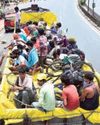The demand of Lingayats for a separate religious tag, delinked from the Veerashaiva Hindu faith, is shrouded in political intrigue. Even as Hindutva’s aggressive adherents find themselves in a dilemma, the Congress hopes to gain electorally from fuelling the demand.

THE numerically and politically strong Lingayat community of Karnataka has always had a paradoxical relationship with the Hindu faith, but its demand to be recognised as a separate religion, at a time when the State is scheduled for Assembly elections in months to come, has serious religious and political ramifications.
The community, which has a dominant presence in northern Karnataka, has been the trusted vote bank of the Bharatiya Janata Party (BJP) for about two decades. In fact, it has been the saffron party’s battering ram to make inroads into Karnataka in particular and southern India in general.
Lingayats have been assiduously wooed by Hindutva advocates, but for at least half a century now the community’s leaders have been persistent in their demand that it be recognised as a separate religion outside the Hindu fold. Herein lies a dilemma for the champions of Hindutva: how to maintain the community’s separate identity after aggressively homogenising it within a monolithic vision of what constitutes Hinduism.
The current controversy has its roots in the massive gathering of Lingayats on July 20 in Bidar town to demand legal status for their community as a separate religion. The rally assumed importance not just because of the numerical strength of the gathering and its timing but its insistence that Lingayats and Veerashaivas, together classified in the Other Backward Classes (OBC) category and used synonymously for all administrative purposes, constitute different faiths. The protesters insisted that Lingayats, the “true followers” of the 12th-century social reformer Basaveshwara (Basavanna/Basava), constituted a separate religion, while Veerashaivas were no more than a sect of the Hindu Saivite faith.
هذه القصة مأخوذة من طبعة September 15, 2017 من FRONTLINE.
ابدأ النسخة التجريبية المجانية من Magzter GOLD لمدة 7 أيام للوصول إلى آلاف القصص المتميزة المنسقة وأكثر من 9,000 مجلة وصحيفة.
بالفعل مشترك ? تسجيل الدخول
هذه القصة مأخوذة من طبعة September 15, 2017 من FRONTLINE.
ابدأ النسخة التجريبية المجانية من Magzter GOLD لمدة 7 أيام للوصول إلى آلاف القصص المتميزة المنسقة وأكثر من 9,000 مجلة وصحيفة.
بالفعل مشترك? تسجيل الدخول

How Not To Handle An Epidemic
The lockdowns were meant to buy time to put in place appropriate health measures and contain the coronavirus’ spread, but they have failed to achieve the objective and heaped immense misery on the marginalised sections of society. India is still in the exponential phase of the COVID-19 infection and community transmission is a reality that the government refuses to accept.

Tragedy on foot
As the COVID-19-induced lockdown cuts the ground beneath their feet in Tamil Nadu, thousands of migrant workers are trudging along the highway to the relative safety of their upcountry homes.

Sarpanchs as game changers
Odisha manages to keep COVID-19 well under control because of the strong participation of panchayati raj institutions and the community at the grass-roots level under the leadership of Chief Minister Naveen Patnaik.

Scapegoating China
As the COVID-19 death rate spikes and the economy tanks in the United States, Donald Trump and his advisers target China and the World Health Organisation with an eye to winning the forthcoming presidential election.

New worries
Kerala’s measured approach to the pandemic and lockdown has yielded results. But it still has to grapple with their huge economic impact on its economy, which it feels the Centre’s special financial relief package does little to alleviate.
No love lost for labour
Taking advantage of the lockdown and the inability of workers to organise protests, many State governments introduce sweeping changes to labour laws to the detriment of workers on the pretext of reviving production and boosting the economy.

Capital's Malthusian moment
In a world that needs substantial reorienting of production and distribution, Indian capital is resorting to a militant form of moribund neoliberalism to overcome its current crisis. In this pursuit of profit, it is ready and willing to throw into mortal peril millions whom it adjudicates as not worth their means—an admixture of social Darwinism born of capital’s avarice and brutalism spawned by Hindutva. .

Understanding migration
When governments and their plans are found to be blatantly wanting in addressing reverse migration, exercises such as the Ekta Parishad’s survey of migrant workers throughout India can be useful to work out creative long-lasting solutions.

Waiting for Jabalpur moment
The Supreme Court’s role in ensuring executive accountability during the ongoing lockdown leaves much to be desired. Standing in shining contrast is the record of some High Courts.

An empty package
The Modi regime, which has been unable to control the COVID-19 infection, restore economic activity and provide relief to millions exposed to starvation, trains its sights on Indian democracy, making use of the panic generated by fear and a lockdown that forecloses paths of resistance.